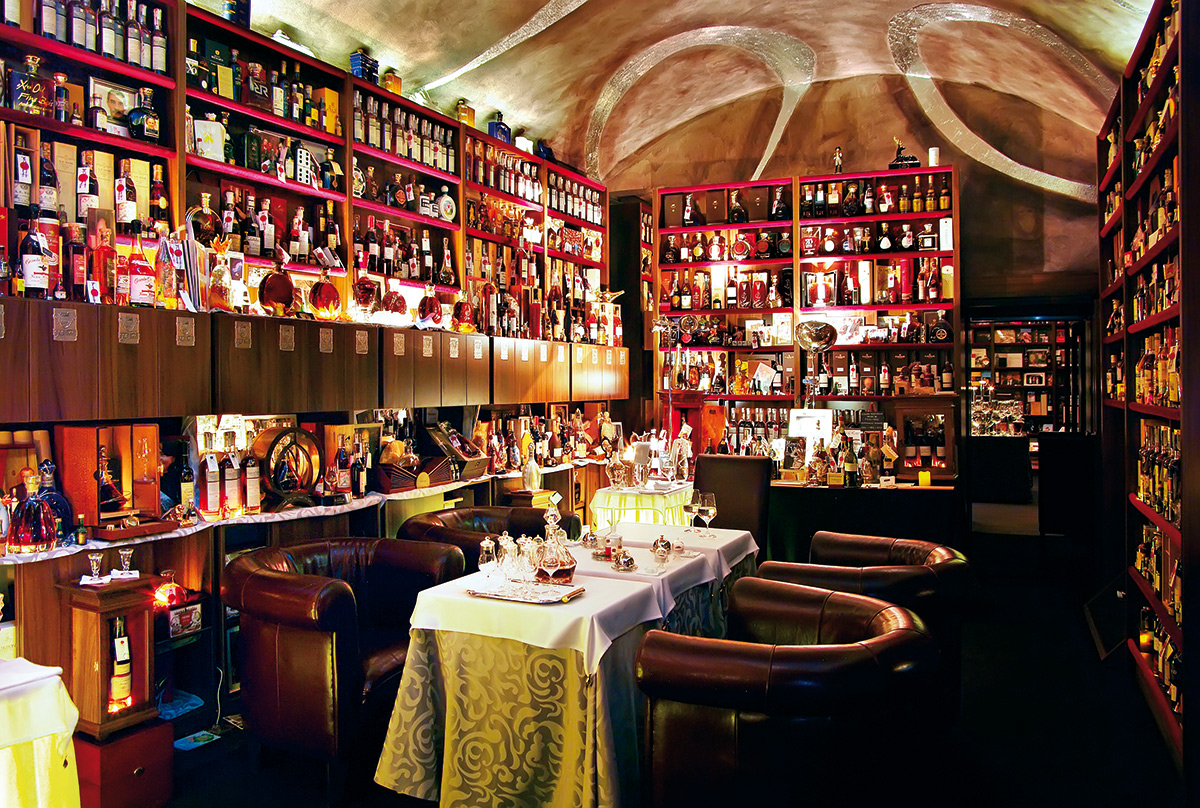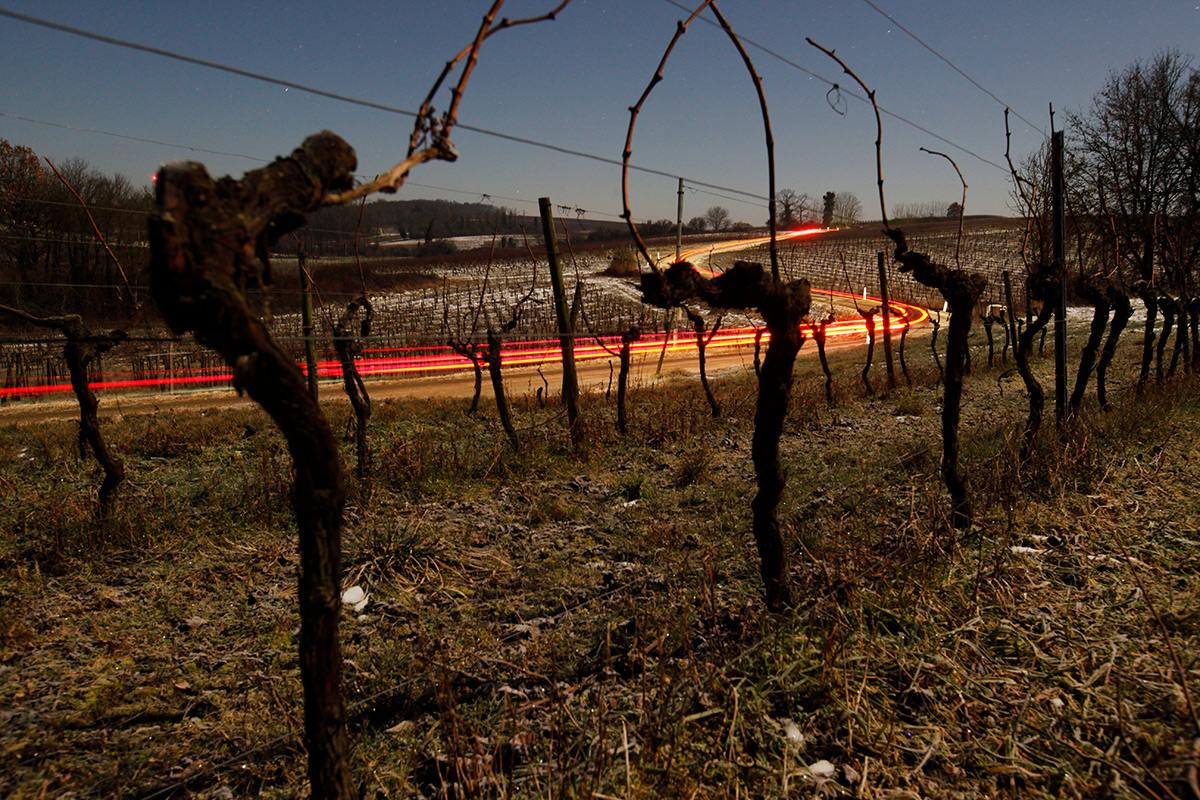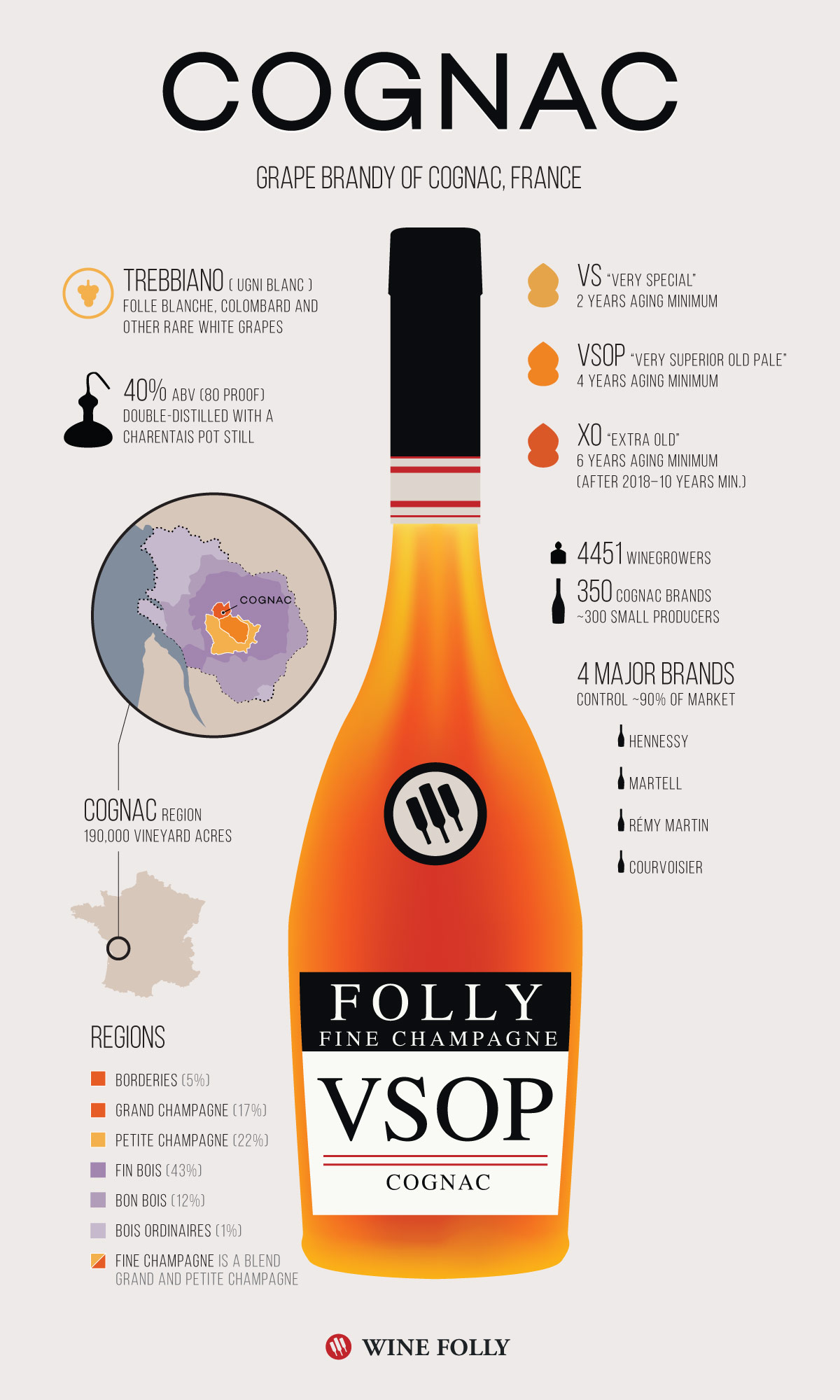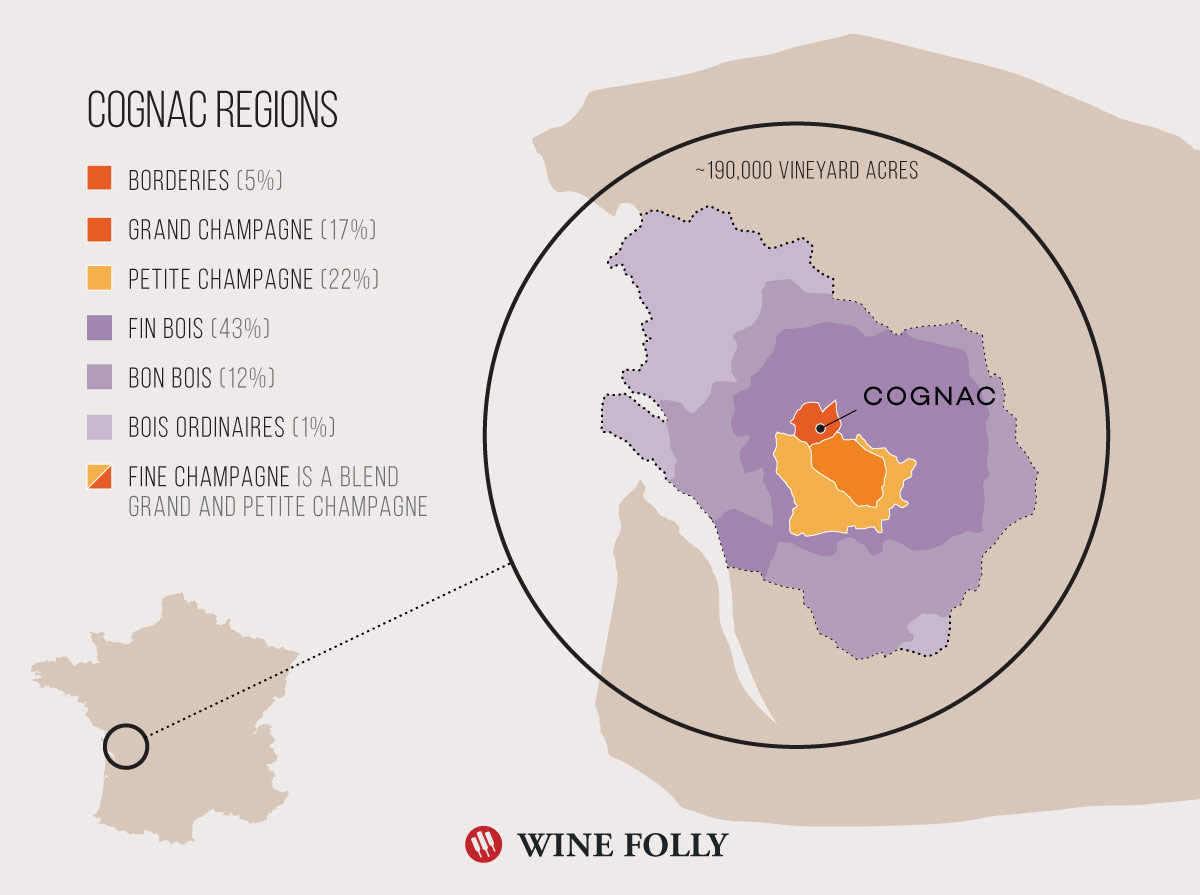Cognac is a brandy made from the white wine grapes grown in the Cognac region of France. Learn how to find great Cognac by understanding the region, the aging classifications, the major brands, and what to look for on the label.

A room for a very lucky few. The Cognac Embassy in Kosice, Slovakia with thousands of different Cognac brandies.
What is Cognac?
All Cognac is brandy, but not all brandy is Cognac.
Cognac is a wine grape brandy from the Cognac region of France (a region just North of world-famous Bordeaux!). This region is a controlled designation of origin, or AOP (Appellation d’Origine Protégée), with many rules and regulations regulating the quality of all the styles of Cognac.
This is a good thing.
It means every Cognac you drink comes with a stamp of authenticity. Let’s take a closer look at Cognac and the details of the grapes at the core of the production of this world-renowned brandy.
The Grapes of Cognac
There are three main white wine grape varieties used in the production of Cognac:
- Trebbiano Toscano (known as Ugni Blanc “ooo-nee blonk” in France)
- Folle Blanche
- Colombard
Ugni Blanc makes up 98% of the region’s 196,000 acres (79,600 hectares – 4x the size of Napa Valley!) and is blended occasionally with Folle Blanche or Colombard. Winegrowers also have the possibility of using up to 10% of other grape varieties too, which include the rare varieties of Folignan, Jurançon blanc, Meslier St-François, Montils, or Semillon.
Before Brandy, Cognac is Wine
Prior to becoming Cognac the brandy, the white grapes are fermented into wine. Because the region is so cool, Trebbiano grapes produce very acidic grapes with low levels of sweetness, which means the wines are very tart with low levels of alcohol (7–9% ABV).
One peculiarity of this type of winemaking is that Cognac producers are forbidden to chaptalize (add sugar) or add sulfur to their wines; this ensures that the base wine is pure, without additives that may affect the distillation.
After the alcoholic fermentation is complete, the wines also undergo a process called malolactic fermentation. Malolactic fermentation is a process where tart malic acid in wine is converted to creamier tasting lactic acid. The process also slightly reduces the acidity of Cognac based wines.

Cognac is often enjoyed in a round, almost globe-shaped glass to better collect the spirit’s complex aromas. The most proper glass for Cognac is a tulip-shaped glass. by Johan Larsson
Cognac is Distilled in Special Charentais Pot Stills
Continuous distillation (how gin and vodka are made) is prohibited in the production of Cognac. Instead, producers abide by the long-established method of double-distillation with a special kind of alembic pot still called a “Charentais” copper still.
The distillation starts the 1st of November and is required to be completed before the 31st of March. Cognac’s aging then begins on the 1st of April following the harvest. From this date we count the age of the Cognac (save for vintage Cognac, which is labeled the date of the harvest).
The spirit that then emerges is referred to by the French as eau-de-vie (“oh duh vee”), or “water of life,” and has a maximum alcohol content of 72.4% ABV (148.4 proof). At this stage, Cognac is completely transparent (clear) with very concentrated fruity peach-like aromas.
The “Cognac Color” Comes from Aging
Cognac gets its color and the rich aromas of caramel, toffee, leather, coconut, and spice from oak aging. Oak barrels traditionally come from the Limousin and Tronçais forests, although today they may come from elsewhere.
There are two types of oak used for Cognac: sessile and pedunculate oak. Sessile oak is known to release less tannin (which can make Cognac astringent) and more methyloctalactones (aka “whiskey lactone,” which are impact compounds that give off aromas of wood, cola, and coconut). Here are some facts about aging Cognac:
- Eaux de vie must age at least two years to be called Cognac.
- The color can become darker as Cognac ages (although there are cases of very old Cognacs aged in old wood that have a very pale color!)
- The different types of Cognac, including VS, VSOP, and XO, specify different aging requirements.
- A portion of eaux-de-vie evaporates during aging (about 2% of total inventory–the equivalent of 22 million bottles per year!).
- Pure, distilled or demineralized water is added to Cognac to make a finished product that is 40% ABV (although some producers sell aged “cask strength” Cognacs at around 50%–60% where evaporation has reduced ABV naturally–check out Cognac Grosperrin)
- Alcohol evaporation is poetically called the “Angel’s Share.”
- The use of caramel color, boisé, and sugar is allowed to adjust the taste/look of Cognac before release. Boisé is created by boiling wood chips in water, then removing the chips and slowly reducing the remaining liquid. By the way, these methods are seriously frowned upon in fine Cognac but are quite prevalent large production VS where darker color is associated with quality.
Cognac Types are Created With Blending
Most of the Cognac brandies we know are blends. That is the magical job of the cellar master: to combine and blend hundreds of different eaux-de-vie and to create perfectly balanced blends with the typical character of each producer. There are three primary types of Cognac in the market today:
Types of Cognac
- V.S. Very Special (minimum of two years of cask aging)
- V.S.O.P. Very Superior Old Pale (minimum of four years of cask aging)
- X.O. Extra Old (minimum of six years of cask aging, but the law will change, and from 2018 it is going to be 10 years)
Beyond the primary three types of Cognac there are several other names and titles used on Cognac bottles, such as: Premium (VS), Extra (essentially VSOP– with at least six years aging), Napoleon (between VSOP and XO), Vintage (a single vintage Cognac), Réserve Familiale (Family Reserve), Très Vieille Réserve (Very Old Reserve), Extra, Hors d’Âge, and Heritage (which can have 40, 50, 60 or more years of aging!). These aforementioned specifications are closely monitored by the appellation board of France.
Other names like “black” or “double oaked” or “very fine Cognac” are used by brands to market their Cognac brandies to signify a special batch (which might even be a recipe that includes the addition of caramel color or sugar!).
So, if you want an official designation of quality, look at the official classification and get the producer’s notes for that bottle.

Cognac Brands
When we start to know the Cognac world better, we find out there are four big brothers– they are the biggest known Cognac brands. These four brands rule over 90% of the market in the world. The fifth biggest, Cognac Camus, is still run by a single family.
Biggest Cognac Brands:
- Hennessy
- Martell
- Rémy Martin
- Courvoisier
In the region there are 4,451 winegrowers, but only few (around 350) created a brand label, and sell Cognac under their name. Around 300 from these “few” are small producers.
Most producers sell their base wines and eaux-de-vie to the bigger brands, keeping a small part for themselves. Some sell only a few thousands or few hundred bottles per year, and most do not export!
If you visit the region, you will uncover very interesting organic, and even biodynamic producers! Cognac is truly a wonderful and big industry made up of about 16,800 active individuals, and more than 50,000 people live off the production of Cognac. It is a symbiosis between the big and small producers. One would not exist without another.
The Region of Cognac
Cognac can be produced only in the small region of France, around 100 km north of Bordeaux – the department of Charente and Charente-Maritime, mainly. It is produced on the left side surrounded by the Atlantic Ocean, and on the right side by Massif Central foothills.
In the mid 19th Century, a gentleman named Henri Coquand, a professor of geology, studied the region’s soils and developed a soil classification based on the quality of eau-de-vie (water of life-transparent spirit we get from the second distillation) that each soil could produce. This is what initiated the identification of different sub-regions of Cognac.

The Crus of Cognac
Grande Champagne (about 17% of production)
Light eaux-de-vie with the predominant floral bouquet. They require long aging in oak to achieve full maturity. The soils have soft chalk, with outlying areas of more hard limestone, sand, and clay.
Petite Champagne (about 22% of production)
Similar to Grande Champagne, but without the exceptional finesse. The soils here are similar to Grande Champagne, but the soft chalky areas are deeper and less porous, which changes the way the plants receive nutrients.
Borderies (about 5% of production)
The smallest cru, which produces fine and round eaux-de-vie, with the very smooth aroma of violets.
Fins Bois (about 43% of production)
Round, supple eaux-de-vie that ages fairly quickly with an aroma of freshly pressed grapes.
Bons Bois (about 12% of production)
These eaux-de-vie age quickly.
Bois Ordinaires (about 1% of production)
Similar to Bons Bois, but with more rustic character.
Each cru (region) has a specific character, and gives different aromas to wines and eau-de-vie. If you do not see any of these names on the label, it is almost for sure a blend of different aged eaux-de-vie from different areas. Although, we can also find single varietal Cognac brandies from each cru. Exciting! If there is “1er Cru” written on the label, it is a Cognac solely from Grande Champagne.

Vineyards of Ugni Blanc (aka Trebbiano Toscano) in Cognac winter. photo courtesy Cognac Embassy.
Cognac’s Heritage and Terroir
Merchants from Scandinavia, United Kingdom, or Ireland fell in love with the region, and created companies in the region. This is the reason why many of the brand names in Cognac are not French (e.g. Richard Hennessy–Irish, Jean Martell was from Jersey, Larsen, Braastad, Bache-Gabrielsen, Birkedal Hartmann–all Norwegian names!). This also explains why the quality levels of VS, VSOP, and XO are in English.
Interestingly enough, only 2–3% of Cognac is sold in France and almost all of the Cognac production is exported. The largest market is the US (with a strong community of African Americans, such as those drinking VS quality in clubs), then the next largest markets are Singapore and China.
In the region you’ll note the use of word Champagne is not a coincidence. The soils are very similar to that region in the northeast of France – clayey, chalky, thin, and full of limestone. In French, Grande means big and in this area we find bigger hills. In Petite Champagne there are smaller hills.
The Bois or the Woods are translated as follows: fine, good, and ordinary woods. A simple explanation is that there were lots of dense woods before the vineyards were planted in the region and the adjectives don’t necessarily pertain to the quality. Although to be fair, a great deal less fine Cognac is sourced from these regions due to classifications, market presence, and the prestige of Champagne and Borderies areas.
Finally, here are a few dates to show the progression and history of Cognac:
- The delimited region for the production of Cognac was established in 1909
- The decree from 1936 mentioned the allowed grape varieties to use for the elaboration of wine
- In 1938, Cognac started to use the six districts of production



